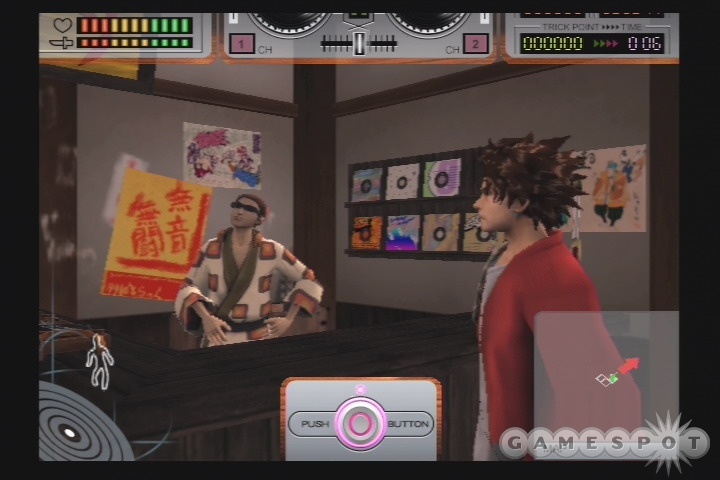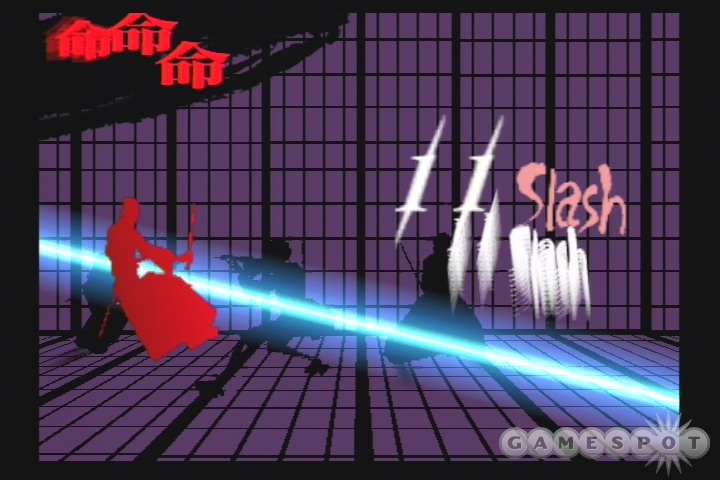From Ghost in the Shell to Yu-Gi-Oh!, the majority of anime-license-based video games tend to go for the lowest common denominator. As if the core audiences of these games have never played a real shooter, fighting game, role-playing game, or any other borrowed genre before, anime games generally seem to dumb down their mechanics to the point of banality and attempt to make up for it by including various bits of esoteric fan service that nobody who hasn't watched every single installment of said anime will give a flip about. Namco Bandai's Samurai Champloo: Sidetracked isn't completely above such pandering. A hack-and-slash action game based on the popular anime series that combines feudal Japan and hip-hop culture in ways that would make even the Wu-Tang Clan scratch their collective heads, Sidetracked doesn't do anything special on the gameplay front. It's basically a button masher that sends waves of dim-witted enemies at you for long stretches at a time and occasionally throws in some challenging boss fights and oddball minigames for good measure. But unlike most other games that take name and inspiration from anime, Samurai Champloo has appeal outside of its core audience. The dialogue, story, and style of the game are all delivered well enough to appeal to those unfamiliar with the series, and there's something oddly compelling about the game's brand of action, even if it is completely repetitive.

Samurai Champloo follows the continuing adventures of Mugen, Jin, and Fuu. For those who haven't been keeping up with the anime's storyline, the gist is that Mugen and Jin are unemployed swordsmen who are rescued from execution by a bubbly girl named Fuu. Fuu is on the hunt for "the samurai who smells of sunflowers," so Mugen and Jin grudgingly repay their debt to her by following her on her journey and protecting her as best they can. The trio is a comically mismatched group--Jin is more the cerebral type, whereas Mugen plays the brash and generally unreasonable role. In fact, the only thing any of the three have in common is their almost unhealthy obsession with food. The game's subtitle, Sidetracked, refers to the plot's nature as sort of a side story for the original anime series. In the game, Mugen, Jin, and Fuu settle into a town for a short rest, only to find themselves wrapped up in a conflict of mythological proportions between rival clans, European interlopers, and mystical prophecies.
The story veers wildly while still managing to maintain a degree of coherence with the overall plot. You play the game as both Jin and Mugen separately, and their stories are almost totally different. Some of the locations recycle, but the setups and boss fights are never the same. The common thread is that both characters are frequently getting into trouble with various enemies and random samurai who want to challenge them for seemingly no reason. It's amusing stuff, thanks largely to the voice acting and sharp writing. The game nails the tone of the anime pretty well, with lots of non sequiturs and random moments of hilarity, punctuated by plenty of sword battles and a hip-hop- and electro-fueled soundtrack. The gags might not fly for those who don't think the anime brand of humor is funny, but if it's your thing, some of the conversations in this game will knock you flat. The principal American voice actors from the anime series are on hand and do their characters justice here. The soundtrack itself is a little scattershot, though most of the tunes are fairly catchy, and it's more than simple background fodder.
The soundtrack plays into Samurai Champloo's combat system. Before you begin any stage, you start out in the town, where several shops are available to you. One of the shops is a record store. As disconcerting as it is to find a record store in feudal Japan, what's even kookier is that the records you buy and use determine the combos you can use throughout the game. Each track contains a unique attack tree, with specific orders of buttons to pull off special combos and attacks. It's nothing too complex, mind you. There are only two attack buttons (weak and strong) to worry about. There is a technique button that changes things up a bit when used in conjunction with an attack button, but for the most part you don't need to mess with this, save for very specific battles. To pick out and select tracks, you simply go to the record store and select two tracks to bring into the stage with you, and you can switch back and forth between them as the stage goes on, effectively giving you two specific battle styles to play with.
This system definitely makes the combat a lot cooler than it would be without it, but still, there's not a lot of depth to the action. You can get by exclusively hammering on the two attack buttons in just about any order, as the majority of enemies you face (except for those in the last couple of levels) don't put up much of a fight. Bosses tend to require more use of the block button, as well as more deft use of the combo systems, but once you've figured out the basic attack patterns for each boss, it's not hard to dispatch any of them. The final boss fights in particular are rather weak.
Still, Samurai Champloo finds ways to make its method of button mashing entertaining, almost in spite of itself. The moves that Mugen and Jin can pull off look cool, and there are a few special moves that are completely insane, such as the attacks used on special enemies. Special enemies appear with stars surrounding them, and simply by hitting these enemies, you jump into a new screen where an attack button appears right before the moment of impact. If you press it fast enough, you'll jump into a button-mashing minigame where you have to hammer on all the attack buttons until you've slashed the enemy 100 or more times. If you pull it off, the game then cuts to yet another scene. Here, everything goes all Kill Bill, with a silhouette of your character fighting silhouettes of several enemies in a dojo that changes to all the colors in the neon rainbow as you go. Once you've killed a hundred enemies here, everything goes back to normal. Stuff like this and the way the game spreads out its various, sometimes long-winded cutscenes throughout each stage do sometimes make the game's pacing rather maddening, but it's an intriguing brand of madness that Samurai Champloo dabbles in, and if nothing else, it's not dull.
Some of Samurai Champloo's brazen sense of style can be attributed to the anime license, but some of the credit has to go to developer Grasshopper, the same team that produced last year's second-most-outrageous game, Killer7. Some of the game's more minor stylistic touches even seem to come directly from Killer7. Similar text fonts are used, the visual effect for enemy death is markedly similar to Killer7's, and there's even a reference to Heaven's Smile buried in the storyline. But that's not to suggest that Samurai Champloo is just Killer7 all over again. There's plenty of original crazy to be found here. A lot of it is found in the enemy designs. Bosses are garish, over the top, and absurd, be it a dandy Eastern European aristocrat with a Chinese opera hairdo and pantaloons, or a wacky kimono-sporting witch that hounds Mugen for seemingly no reason at all. Even the lower-level enemies are strange. One moment you'll be battling simple samurai soldiers, and the next moment you'll be up against monkeys with knives in their mouths.

With all that said, most of what makes Samurai Champloo interesting to look at is its style and not its technical prowess. The main characters are pretty well detailed, but some of their animations don't look quite right, especially during in-engine cutscenes, where their mouths barely seem to move during conversations. Enemies are considerably less detailed, and there are only a handful of different enemies to fight. You tend to end up fighting carbon copies of the same guy over and over again for long stretches. Environments are stylish but are devoid of decent textures or lighting. The camera also can be extremely dumb. The angles are fixed, and you have zero control over the camera, which is very unfortunate, considering that when you get too close to walls or areas where the camera angles change, things tend to get very spastic, very quickly.
Fortunately, Samurai Champloo's style shines through over many of its rough spots. Technically it may be just another hack-and-slash anime game, but it's a lot more entertaining than that meager distinction, and it has more to offer than your typical licensed fare. With its three unique storylines (there's a third, unlockable character to play as once you've beaten one of the stories), each of which take several hours to complete, you could conceivably find yourself spending a great deal of time playing Samurai Champloo. Undoubtedly, you will hit spots during that time where the combat will simply wear on you, but it usually takes just one random encounter with another completely bizarre character or some new hip-hop tracks to suck you back in. Those with a severe aversion to anything anime won't have their minds changed by Samurai Champloo, but those without such an aversion ought to find something to like about it.